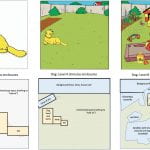Faculty and students presented at ASHA 2022 in New Orleans, LA.
Improving the Design of AAC Systems
For individuals with complex communication needs, the visual features of an AAC display play a key role in supporting successful use. At present, many AAC systems have limited visual appeal, and may be viewed as complex in ways that make the system less effective.
From a visual perspective, a well designed AAC display
• is appealing
• presents information clearly
• is easy to learn and use
Our research challenge is to use what we know about learning/development and human visual processing to design AAC systems that are fun, linguistically powerful, and intuitive. When we design AAC systems that incorporate key visual features, individuals want to use them to communicate in play/leisure, academic, and social activities. We are exploring questions of visual design through both basic (e.g., behavioral and neuro-imaging technologies) and applied research studies (e.g., use of prototype displays in interactions that are personally relevant to the individual). We also know that the complexity of programming demands has an impact on how often vocabulary is added to systems. In order for AAC to be responsive to immediate needs, we have extensively explored and applied “just in time” (JIT) programming. JIT softwares are key not only because they reduce the workload of adding vocabulary by not requiring everything to be compiled ahead of an interaction, but also because the resulting communication supports have been optimized for that particular individual and situation within any given moment.
The Relation of Visual Attention to Stimulus Complexity and Functional Vision in Individuals With CVI: Implications for AAC (McCarty et al., 2021)
McCarty, T. V., Sowers, D. J., Wolf, S. J., & Wilkinson, K. M. (2021). A preliminary study of the relation of visual attention to stimulus complexity and functional vision in individuals with Cortical Visual Impairment: Implications for augmentative and alternative communication. Perspectives of the ASHA Special Interest Groups, 6(6),1603-1617. https://doi.org/10.1044/2021_PERSP-21-00112 Individuals with cortical visual impairment (CVI) can have […]
Visual attention to cued targets in AAC (Wilkinson et al., 2021)
Wilkinson, K. M., Zimmerman, T. O., & Light, J. (2021). Visual attention to cued targets in simulated aided augmentative and alternative communication displays for individuals with intellectual and developmental disabilities. Journal of Speech, Language, and Hearing Research, 64(5), 1726-1738. https://doi.org/10.1044/2021_JSLHR-20-00451 FREE on PubMed Purpose Many aided augmentative and alternative communication (AAC) systems require the use of […]
Personalized AAC to increase participation and communication for an adult with Down syndrome (Babb et al., 2021)
Babb, S., Jung, S., Ousley, C., McNaughton, D., & Light, J. (2021). Personalized AAC intervention to increase participation and communication for a young adult with Down syndrome. Topics in Language Disorders, 41(3), 232-248. https://doi.org/10.1097/TLD.0000000000000240 FREE on PubMed Background Many adults with Down syndrome experience difficulty with speech production; communication breakdowns are common, especially with unfamiliar communication […]
Impact of video VSDs on peer social interaction for adolescents with ASD (Babb et al., 2021)
The use of a video visual scene display (VSD) approach increased peer interaction for autistic adolescents (Babb et al., 2021)




